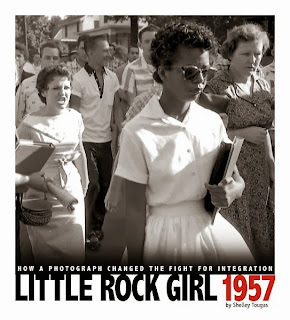The historic Civil Rights Movement is very much in the news these days, with the anniversary of the March on Washington, the Children’s Crusade March in Birmingham, and more. The next several years will bring other anniversaries of important events to remember and ponder. Fortunately, books for young people offer a rich array of nonfiction on the Civil Rights Movement. Since children and teens played a vital role in the movement, focusing on them is an excellent way to narrow the topic. Middle and high school readers may be more engaged than usual with these history books because the main actors are young people. For young people today who may feel they make little difference in their world, the accounts of teens who did may be a real inspiration.
Two excellent books that introduce
a lot of young people and the dangers they faced to further civil rights are
Cynthia Levinson’s We've Got a Job: The 1963
Birmingham Children's March (Peachtree,
2012) and Elizabeth Partridge’s Marching
for Freedom: Walk Together, Children, and Don't You Grow Weary (Viking, 2009). Students could compare these books for the
Common Core, looking at structure, voice, use of photographs, and more.
Two
books that give personal views of the integration in 1957 of Little Rock High
are Melba Patillo Beals’ Warriors Don't Cry: A Searing Memoir of the Battle
to Integrate Little Rock's Central High (Pocket, 1995) and Shelley Tougas’s
Little Rock Girl 1957: How a Photograph
Changed the Fight for Integration (Compass Point, 2012). Both concern girls who were among the nine
students to integrate the high school amidst hostility and even violence. The Beals book is a powerful memoir; the
Tougas book is a photo-essay that focuses on a photograph of Elizabeth Eckford,
another of the Nine. They could be used
together, with the Beals’ book suitable for stronger readers and the Tougas
book for those who need shorter texts and more visual support.
Two other excellent texts
highlight teens who made a significant difference. Claudette Colvin: Twice
toward Justice (Melanie Kroupa, 2009) by Phillip Hoose tells of a teenage
girl who not only refused to give up her bus seat in Montgomery before Rosa
Parks but later was one of the plaintiffs when civil rights leaders sued in
federal court to end segregation on the buses.
Because Hoose interviewed multiple times, Colvin’s voice conveys her
difficult, important story.
John Stokes was also part
of a major civil rights lawsuit, Brown v.
Board of Education. He tells his powerful
story, with Lois Wolfe and Herman J. Viola, in Students on
Strike: Jim Crow, Civil Rights, Brown, and Me (National Geographic, 2008). When Stokes was a high school student in
Virginia in the 1950s, he attended an all-black school under the “separate
equal doctrine.” But it was far from
equal to the white school in resources and facilities. He and his fellow students wanted to protest
to get better conditions but ended up, with some reluctance, joining a lawsuit
to integrate the schools. The tough choice brought violent reactions and
shocking retaliation from the county government.
These are all moving stories of great courage, of
kids who put themselves and their families in danger in seeking a better
future, a future with less injustice.
They faced threats, violence, prison cells, police dogs, and more – to make life better future not just for themselves but for those who came after them.






No comments:
Post a Comment